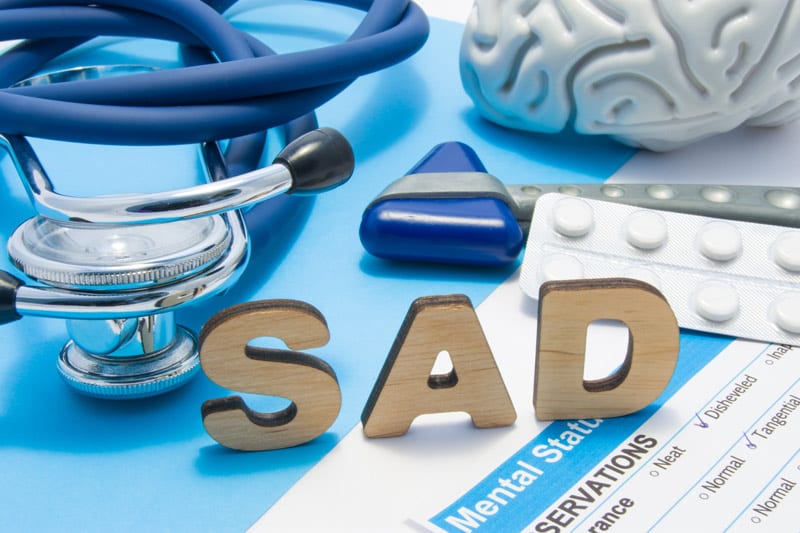Everyone has experienced ups and downs at some points in their lives. The occasional blues and lethargy that you experience may be an aftermath of too much stress after a tiring day. However, if these emotional encounters are happening more regularly and in a recurring pattern, it should be a cause of concern. In particular, if you’re noticing your mood and behavior changes depending on the seasons, you might be suffering from a seasonal affective disorder (SAD).
What Is Seasonal Affective Disorder (SAD)?

Since SAD usually appears at the start of winter, many people mistake seasonal depression as “winter blues” and simply shrug their sadness off, thinking that it’ll disappear in the following days. Therefore, if you’re suddenly feeling down amidst the change of seasons, it’s worth monitoring yourself, then find a psychologist who can help you with your treatment.
Seasonal affective disorder is found to be four times more prevalent in women than men. Also, this mood disorder affects approximately 10 million people in the United States alone, with 10% to 20% experiencing mild SAD symptoms.
Questions To Ask Yourself
Seasonal depression can be difficult to identify on your own. Since winter symbolizes less warmth, light, and color to the surroundings, many people feel that their fire has weakened. If you seldom experience tiredness and depressive mood during this time, it shouldn’t be concerning.
However, if these feelings and behavior regularly persist during the same season every year and are taking control of your life, it’s time to figure out what’s wrong. Since SAD occurs in a yearly pattern, it’ll take a long time to examine yourself and see if you experience this disorder. Below are some of the common signs of SAD:
- You always feel irritated.
- You’ve been gaining or losing weight lately.
- You don’t have much interest in physical contact.
- You don’t enjoy doing activities you used to like before.
- You have trouble sleeping at night, or you feel sleepy all the time.
- You’ve been having extreme cravings for starchy and sugary foods lately.
- You feel hopeless.
- You feel stressed and pressured.
- You get easily tired from doing your daily tasks.
Causes of SAD
The exact cause of SAD hasn’t been identified yet. However, scientists believe that your hormones play a crucial role in altering your mood and attitude at specific seasons in a year. Due to hormonal changes, one can potentially experience SAD.
Another cause to take into account is the lack of sunlight during fall or winter when the first signs of SAD begin. As you receive less sunlight even during the day, this causes your brain to produce less serotonin, a neurotransmitter essential for happiness and well-being. Since SAD is linked to lack of sunlight, people in countries with plenty of sun exposure, such as tropical countries, are less likely to experience SAD.
Symptoms of SAD
As mentioned earlier, SAD is commonly experienced between two seasons of the year: in fall and winter, or spring and summer. These two scenarios can have different symptoms. If most of the questions above seem to apply to you, check out these specific symptoms you’ll likely experience if you have SAD:
1. SAD During Fall and Winter
The symptoms include:
- Weight gain
- Oversleeping
- Social withdrawal
- Tiredness or lethargy
- Changes in appetite, particularly cravings towards food rich in carbohydrates
2. SAD During Spring and Summer
The symptoms include:
- Insomnia or sleeping troubles
- Agitation, restlessness, and anxiety
- Poor appetite resulting to weight loss
- Violent episodes
SAD Treatment
Thankfully, there are several treatments available for SAD, although the treatment options also vary according to the severity of your symptoms.
The easiest and most accessible treatment approach for SAD is exposure to sunlight because of the positive relationship between natural light and one’s mental health. Psychologists and doctors suggest people with SAD get up early in the morning and stay or walk outside to receive sunlight. During the winter months, it’s more difficult since there’s barely any sun, but antidepressant medications can help. The only FDA-approved medication for SAD involving depressive episodes is Bupropion XL.
Since you receive less sun exposure in the winter, another treatment option is phototherapy or light therapy. During this procedure, your eyes will be exposed indirectly to a full-spectrum bright light, which is 20 times brighter than typical room lighting. You’ll be required to position yourself two feet away from this light, with exposure of 10 to 15 minutes per session. As you build your tolerance towards the light, your exposure time can reach 30 to 45 minutes.
Takeaways
Having time to look at yourself and reflect on your thoughts can greatly help you in identifying if you potentially have any issues with different aspects of your health, particularly your mental and emotional health. Developing awareness towards SAD is valuable, especially if you’re currently going through this disorder or know someone who is.
If you or someone you know experiences mental health issues, it is important to seek help from a qualified professional. Our Resource Specialist can help you find expert mental health resources to recover in your community. Contact us now for more information on this free service to our users.
About the Author: Daniel Wilks has worked as a journalist and content producer for over 20 years across print, online, and TV. During this time, Daniel has written over a number of topics including technology, computer games, music, film, books, food, heavy machinery, pop culture, and now, healthcare.
The opinions and views expressed in any guest blog post do not necessarily reflect those of www.rtor.org or its sponsor, Laurel House, Inc. The author and www.rtor.org have no affiliations with any products or services mentioned in the article or linked to therein. Guest Authors may have affiliations to products mentioned or linked to in their author bios only.





